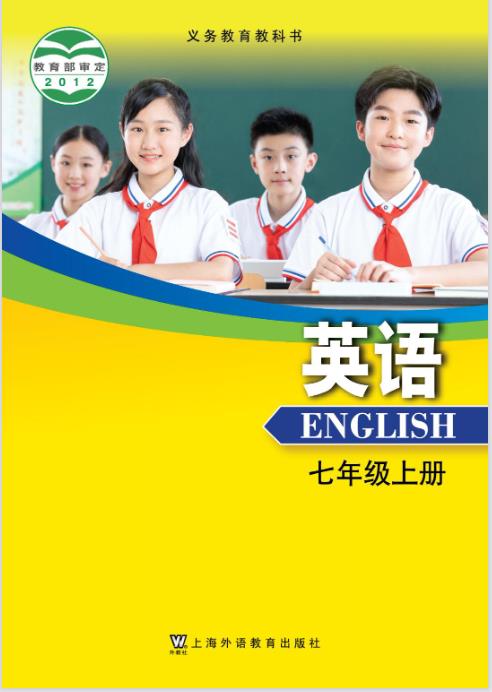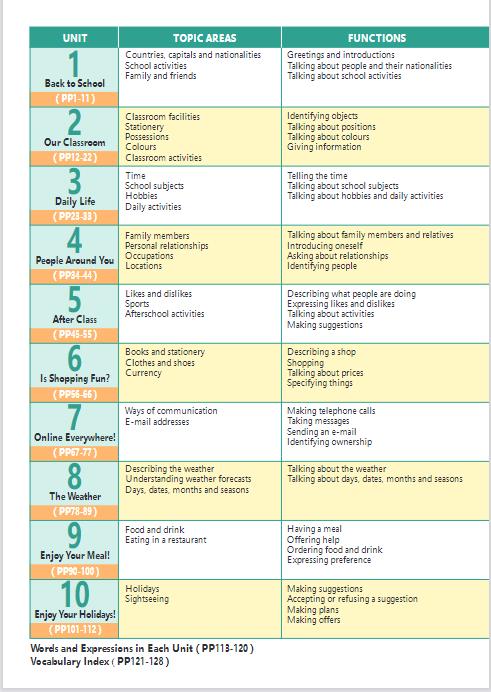提前做好预习能让我们更加顺利地应对接下来的学期生活,那么关于七年级上册英语电子课本怎么预习呢?以下是小编准备的一些沪外教版七年级上册英语电子课本,仅供参考。
七年级上册英语电子课本


查看完整版可微信搜索公众号【5068教学资料】,关注后对话框回复【7】获取七年级语文、七年级数学、七年级英语电子课本资源。
七年级上册英语知识点
Module1
__meet[mi:t]v.认识,遇见
__first[f?:st]adj.第一
__English[’i?gli?]n.英语,英文
lesson[’les?n]n.(一节)课
class[klɑ:s]n.班级
__student[’stju:d?nt]n.学生
Miss[mis]n.女士;小姐(对未婚女性的称呼)
twelve[twelv]num.十二;12
year[j?:]n....岁,年
thirteen[θ?:’ti:n]num.十三
__too[tu:]adv.也,还
__from[fr?m,fr?m]prep.从…来
__close[kl?uz]v.关闭
open[’?up?n]v.打开
match[m?t?]v.相称,匹配;
__write[rait]v.写
practise[’pr?ktis]v.练习
__city[’siti]n.城市
__England[’ingl?nd]n.英国英,格兰
__English[’i?gli?]adj.英语的
fourteen[,f?:’ti:n]num.十四
eleven[I’levn]num.十一
blackboard[’bl?kb?:d]n.黑板
twenty-nine[,twenti’nain]num.二十九
fifty[’fifti]num.五十
Module2
__parent[’p??r?nt]n.父,母;家长(pl.parents父母)
can[k?n,k?n]aux.v.能,能够
__basketball[’ba:skitb?:l]n.篮球
piano[pi’?n?u]n.钢琴
tennis[’tenis]n.网球(运动)
__tabletennis[’teibl][’tenis]乒乓球
__ride[raid]v.骑;开(车)
horse[h?:s]n.马
__welcome[’welk?m]v.欢迎
__international[,?nt?’n???n?l]adj.国际的
__factory[’f?kt?ri]n.工厂
七年级英语上册期中试卷
Ⅰ. 根据句子提示写出单词(10%)
1. I have a toothache. I need to go to the d____________.
2. There are sixty m____________ in an hour.
3. I have to get r____________ for my English test.
4. Sam isn't shorter than Ben. They are the s____________.
5. Carrots, tomatoes and onions are all v____________.
Ⅱ. 从Ⅱ栏中找出与I栏相对应的答语(10%)
Ⅰ Ⅱ 1. Happy birthday! a. Yes, I do.
2. How are you? b. It' very cold.
3. Would you like to come to my birthday party? c. I'm sorry to hear that.
4. How is the weather here? d. Sure. Here you are.
5. Thank you very much. e. Thank you.
6. My mother is ill. f. Fine, thank you. And you?
7. May I use your pen? g. It's a pleasure.
8. Can we go to the park? h. Yes, I'd love to.
9. I hope he'll get better soon. i. OK.
10. Do you see the dentist? j. I hope so.
Ⅲ. 选择填空(20%)
1. —Would you like a cup of tea? —____________.
A. Yes, I like to drink B. Thank you for asking me C. Thanks. That would be nice
2. — How ____________ do you watch TV? —Sometimes.
A. often B. long C. much
3. I am working hard for the test at the moment].
A. then B. now C. just now
4. My father is out now.
A. at work B. at home C. not in
5. I'm afraid I can't help him with his math.
A. I'm sorry B. I'm not free C. I'm afraid of
6. I hope you are very ____________ these days, Granny.
A. good B. well C. health
7. — ____________ your work at the office? —I like it very much and I'll do it better.
A. What's B. Where's C. How's
8. —Do I need bring an umbrella? —I'm afraid you ____________.
A. have to B. can C. need
9. I don't enjoy ____________ with Jack
A. to talk B. talking C. talk
10. I often take ____________ walk after ____________ supper.
A. a; a B. a; the C. a; /
Ⅳ. 句型转换(10%)
1. They are going to work on a farm/next week. ____________ ____________ they going to work next week?
2. It's about a few kilometers. ____________ ____________ is it?
3. The first lesson is easier than the fourth. ____________ lesson is easier than the fourth.
4. The students are picking apples. ____________ are the students ____________?
5. We often go to school on foot. ____________ ____________ you often ____________ to school?
Ⅴ. 完成对话(10%)
Bill: Kate! We are ____________ ____________ have a field trip tomorrow afternoon. Do you know where we ____________ ____________? Kate: Yes, we're going to see the factory. Bill: ____________ are we ____________ ____________ meet? Kate: Outside the school at 1: 30. Bill: ____________ are we ____________ there? Kate: By bus. Bill: ____________! See you then! Kate: See you!
Ⅵ. 根据汉语补全句子(20%)
1. 我们喜欢住在城镇,而我叔叔喜欢住在农村。 We like ____________ in ____________ , but my uncle ____________ ____________ in ____________ ____________.
2. 我的头发比我妹妹的长。 My hair ____________ ____________ ____________ my ____________.
3. 他们班计划下周六去远足。 Their class is ____________ ____________ ____________ Saturday.
4. 我的家离学校不远。 My home ____________ ____________ ____________ my school.
5. 后天我们在哪儿集合? Where are we going ____________ ____________ the day ____________ ____________?
Ⅶ. 完形填空(10%)
Today is Sunday. It's a fine day 1 flying kites. Many children are going out in the open air. They take their kites 2 them. Some kites are big, 3 are small. They have different colours. Every kite 4 a long string. Look! To get the kites up, the children are beginning to 5 . And the kites are flying in the air. 6 happy they look! Now all the kites are high up in the air. The one like a bird is the 7 of all. Oh, dear! 8 string is broken, and it's flying away. What's wrong 9 another kite? It's flying away, too. But the other kites are flying. The children are running after them. They want to get 10 back. The people are watching them and laughing.
1. A. of B. for C. with D. to
2. A. for B. in C. out D. with
3. A. the other B. other C. others D. another
4. A. have B. has C. is D. are
5. A. run B. to run C. running D. runs
6. A. How B. What C. How a D. What a
7. A. higher B. highest C. shorter D. shortest
8. A. It's B. Its C. Their D. Theirs
9. A. for B. with C. to D. about
10. A. it B. they C. them D. his
Ⅷ. 书面表达(10%)
Monday Tuesday Wednesday Thursday Friday Saturday and Sunday go to the movies have a piano lesson go to the dentist play soccer visit my aunt look after my little sister Your friend, Harry invites you to visit his home. But you are very busy next week. You send an E-mail to tell him about your plan. Try to use “I'm doing… or I have to…” Hi Harry, Thanks a lot for your invitation. I can't visit next week. On Monday, I'm going to
七年级上册英语教案
教学内容
Section A(教材P25—27)
教学目标
知识与能力
Section A的主要内容是学会用have对物品的所属进行提问以及应答,学会使用do和does引导的一般疑问句,学会用Let’s…提建议。能够谈论自己喜欢哪些球类运动,不喜欢哪些球类运动。
过程与方法
采用Discussion and guess和Classifying的学习策略,利用实物、教学幻灯片、图片等来展开课堂Pair work问答式的口语交际活动,使用have对物品的所属进行提问及回答。
情感态度价值观
该部分学习内容贴近学生的生活,谈论的主题是符合学生喜爱运动的心理,极易于激发学生学习英语的欲望和兴趣,使他们乐于参与各种英语实践活动。
教学重、难点及教学突破
重点
学习运用重点句型Do you/they have… ? Does he/she have…? Let’s play soccer.等;
语法难点
行为动词have的一般现在时的用法;使用do和does引导的一般疑问句的构成和使用。
教学突破
Section A重在通过使用动词have对物品的所属进行提问和回答的交流式口语活动,学习由助动词do或does引导的一般疑问句的构成以及回答。教师要善于引导学生比较行为动词的疑问句和be动词的疑问句在构成和回答上的区别,通过大量和反复地操练以达到运用自如
教学准备
教师准备
收集课文中所涉及的或学生常见的球类运动器材或有关的教学幻灯片或图片;设计课后巩固练习的幻灯片;制作1a部分的插图和人物对话的课件,将听力部分的内容插人,通过询问对方的所属以及回答来引入新课。
学生准备
搜集自己所了解的或曾经见过的球类运动器材的名称,并通过询问老师、同学或上网查询的方式了解各种运动的竞赛方法。
教学步骤
(1课时)
一、第一教学环节:情景创设,导入新课
教师活动
学生活动
Section A主要内容是通过使用have对物品的所属进行提问和应答,来学会使用do和does引导的一般疑问句。所以在教学中可采取问答式导人法:
1.教学一些球类运动器材名词,教师拿出一个足球或放映幻灯片或出示图片进行演示:I have a footba11.Do I have a football?自己回答:Yes,I d0.再问:Do I have a basketball?自己回答:No,I don’t.再使用其它物体询问学生:Do I have…?询问学生:Do you have…?询问学生:Does he/she have…?询问学生:Do they have…?
1.学生回答:Yes,you do.№,you don’t.学生回答:Yes,I do.No,I don’t.学生回答:Yes,he/she does.No,he/she doesn’t.学生回答:Yes, they do.No,they don’t.
2.学生进行Pairwork对话练习,运用所
学知识进行互动交流。
二、第二教学环节:师生互动,学习探究
教师活动
学生活动
1.播放lb部分的录音让学生听,引导学生圈出所听到的单词,并能画出相应的图片,完成lb部分的教学任务。
2.引导学生展开Pairwork活动,完成lc部分口语交际的教学任务,学会运用助动词do进行问答,可采用师生互动带动学生互动的交流方式:
Do you have…? Yes,I do./No,Idon’t.
1.听lb部分的录音,圈出所听到的单词,并画出相应的图片,完成1b部分的学习任务。
2.Pairwork活动,完成lc部分口语交际的学习任务,学会运用助动词do进行问答。
3.播放2a部分的录音,引导学生选出他们所听到的对话并标明顺序,完成2a部分的教学任务.
4.重新播放2a部分的录音,要求学生将对话中所提到的球类和人物对应起来,并标明顺序,完成2b部分中的听力训练任务。
5.引导学生展开Pairwork活动,完成2c部分口语交际的教学任务。让学生根据图画内容运用动词have进行询问所属,以练习由助动词do/does引导的一般疑问句结构,可采用师生互动带动生生互动的交流方式:
Do you have…?Yes,I do./No.I don’t.Does he/she…?Yes.he/shedoes./No,he/she doesn’t.。
6.引导学生观察3a部分的图画和对话内容,并根据示例捕捉相关信息,从方框内选择合适的词填空。
7.引导学生展开Pairwork活动,完成3b部分口语交际的教学任务。要求学生学会使用Let’s…句型表示“提建议”。可采用师生互动带动生生互动的交流方式:Let’s play soccer.I don’t have a soccer ball.Well,let’s play volleyball.That sounds good.。
3.听2a部分的录音,选出他们所听到的对话并标明顺序,完成2a部分的学习任务。
4.重听2a部分的录音,将对话中所提到的球类和人物对应起来,并标明顺序,完成2b部分中的听力训练任务。
5.Pairwork活动,完成2c部分口语交际的学习任务。根据图画内容运用动词have进行询问所属,以练习由助动词do/does引导的一般疑问句结构。
6.观察3a部分的图画和对话内容,并根据示例捕捉相关信息,从方框内选择合适的词填空。
7.Pairwork活动,完成3b部分口语交际的学习任务。学会使用Let’s…句型表示“提建议”。
三、第三教学环节:合作交流,巩固提高
教师活动
学生活动
引导学生展开Pairwork活动,完成4部分口语交际和笔头练习的教学任务。要求学生阅读第4部分的短文,并根据短文内容,填写表格,然后互相介绍自己的信息。
Pairwork活动,完成4部分口语交际和笔头练习的学习任务。阅读第4部分的短文,并根据短文内容,填写表格,然后互相介绍自己的信息。